





Jazz legend Duke Ellington would describe people or things that were in a league of their own as 'beyond category'. In the world of shrubs, viburnums have earned the right to be described as such. They are tough, easy to manage, sometimes spectacular plants, that I often describe as the 'Michael Jordan's of my garden.
(Editor's Note: This article was originally published on January 1, 2008. Your comments are welcome, but please be aware that authors of previously published articles may not be able to promptly respond to new questions or comments.)
With jobs and family competing with gardening for our precious time, low maintenance, high 'wow-factor' plants are the gardener's holy grail. Flowering shrubs rank high on that list, and viburnums in particular possess the all-around appeal that makes them true garden 'must-haves'. As with Jordan, one is hard pressed to find a real weakness.
With over 150 species worldwide, including many native to North America, the gardener has a full menu of winners from which to choose. Sizes range from a couple of feet to over 25 feet. There are shrub and tree forms, with many leaf shapes and textures available. Some offer incredible fragrance, others impressive fall color and many a bounty of berries in a range of colors. A number offer all three! Most flowers are various shades of white, though a number are pink. They are not picky about soil or moisture, and many will do quite well in shadier areas. They are in a class that I refer to as 'P & W' plants - 'Plant and Watch'.
For those fragrance lovers among us, there are a number of viburnums whose scent can only be described as heavenly. 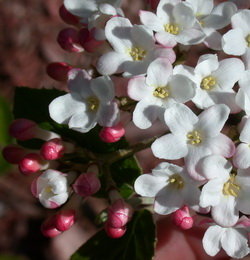 Most of the fragrant species are Asian varieties, though many fragrant hybrids have been introduced in the U.S. Perhaps the mother of all fragrant viburnums is the Korean spice viburnum (V. carlesii). In the spring, this shrub, which reaches six or more feet tall, will literally fill the entire garden with its spicy sweet fragrance. The flowers, which start pink and fade to white, can be the size of softballs. It can be susceptible to mildew however. Varieties with comparable fragrance, but better mildew resistance include 'Cayuga', introduced by the U.S. National Arboretum, and Judd viburnum (V. juddii). I grow both. 'Cayuga' reaches four to five feet and Judd about six to eight feet tall. For those looking for even smaller fragrant varieties, there is a dwarf Korean spice called 'Compactum', which will top out at about three or four feet tall. I grow another beauty, a Burkwood viburnum called 'Mohawk', which is another USNA introduction. The bright red buds open slowly to reveal the clove-scented white flowers. The entire bud to flower drop period lasts weeks!
Most of the fragrant species are Asian varieties, though many fragrant hybrids have been introduced in the U.S. Perhaps the mother of all fragrant viburnums is the Korean spice viburnum (V. carlesii). In the spring, this shrub, which reaches six or more feet tall, will literally fill the entire garden with its spicy sweet fragrance. The flowers, which start pink and fade to white, can be the size of softballs. It can be susceptible to mildew however. Varieties with comparable fragrance, but better mildew resistance include 'Cayuga', introduced by the U.S. National Arboretum, and Judd viburnum (V. juddii). I grow both. 'Cayuga' reaches four to five feet and Judd about six to eight feet tall. For those looking for even smaller fragrant varieties, there is a dwarf Korean spice called 'Compactum', which will top out at about three or four feet tall. I grow another beauty, a Burkwood viburnum called 'Mohawk', which is another USNA introduction. The bright red buds open slowly to reveal the clove-scented white flowers. The entire bud to flower drop period lasts weeks!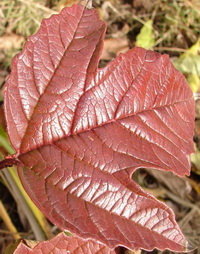
Many viburnums are grown for their berries. They are produced in a variety of colors and shades - yellow, red, pink, blue and near black. There are a number that change color as they age. My 'Erie' linden viburnum (V. dilatatum 'Erie') produces berries that ripen from orange-red, to red, and finally to a coral color as fall approaches. My doublefile viburnums, on the other hand, produce berries that resemble a candy I loved as a kid - Red Hots - in both size and color. Another favorite, V. nudum 'Winterthur', has berries which age from light pink to deep pink to blue, and finally to a near black purple. Even more interesting is that in late summer and early fall, the berries appear in these various colors at the same time! The contrast of the pinks to the purples is stunning. 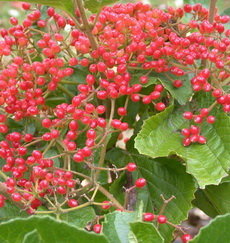 Though viburnums are monoecious, meaning their flowers have both male and female organs, and thus can pollinate themselves, they don't do a very good job of it. In Nature, pollination usually works better when others are involved! For the best fruit production, good cross-pollination is a must. For this reason, it is best to plant two distinct varieties of a given species. For example, I planted one 'Michael Dodge' linden viburnum to cross-pollinate my three 'Erie'. 'Michael Dodge' gets beautiful yellow berries itself! Check with your nursery or local county extension office to verify that you have the
Though viburnums are monoecious, meaning their flowers have both male and female organs, and thus can pollinate themselves, they don't do a very good job of it. In Nature, pollination usually works better when others are involved! For the best fruit production, good cross-pollination is a must. For this reason, it is best to plant two distinct varieties of a given species. For example, I planted one 'Michael Dodge' linden viburnum to cross-pollinate my three 'Erie'. 'Michael Dodge' gets beautiful yellow berries itself! Check with your nursery or local county extension office to verify that you have the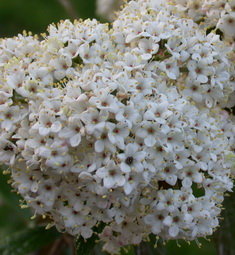 best plant match-ups for maximum fruit production. Not only will you be rewarding yourself with the beauty that berries afford, but you'll also be providing a great food source for birds. The number of birds that frequented my garden jumped dramatically when I added these beauties to my garden.
best plant match-ups for maximum fruit production. Not only will you be rewarding yourself with the beauty that berries afford, but you'll also be providing a great food source for birds. The number of birds that frequented my garden jumped dramatically when I added these beauties to my garden.
There are a number of advantages to planting native viburnums. DG's own resident viburnum expert, viburnumvalley, advocates their use since they bring 'the advantage of natural adaptation to the region'. Thus they are already 'tested' in your area and thrive in your local conditions. Additionally, he emphasizes that their use 'would also be supporting the local birds and other wildlife that would normally feed on the fruits'. He suggests a shrub form and a tree form, if one has the space. His favorite shrub type is arrowwood viburnum (V. dentatum). He likes that they are native to many areas of the country, hardy to at least zone 3 and offer nice white flowers in spring. These are followed by blue fruits (assuming good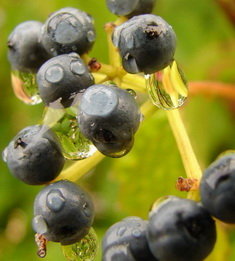 pollination), attractive foliage and a range of fall colors from yellows and oranges through pinks, reds and purples. Sizes range from around five feet to 12 feet tall. I grow a number of these as well, including the popular recent introduction, 'Blue Muffin', which produces lots of shiny blue berries that are bird favorites. One downside to this variety - the flowers stink! The first year I had good flower production, I walked around for days looking for a dead animal I was convinced was rotting in my garden. An eventual sniff of the flower ended the hunt. I now affectionately refer to the plant as 'BM'.
pollination), attractive foliage and a range of fall colors from yellows and oranges through pinks, reds and purples. Sizes range from around five feet to 12 feet tall. I grow a number of these as well, including the popular recent introduction, 'Blue Muffin', which produces lots of shiny blue berries that are bird favorites. One downside to this variety - the flowers stink! The first year I had good flower production, I walked around for days looking for a dead animal I was convinced was rotting in my garden. An eventual sniff of the flower ended the hunt. I now affectionately refer to the plant as 'BM'.
Of course, no plant is absolutely problem-free. Aside from the occasional fungal problem mentioned above, deer do nibble at the foliage. I have a serious deer problem and have to spray all new foliage. Unless you are starting with a puny twig however, deer damage should not threaten the plant's viability. Just remember to keep up with the repellent use.
More serious is the spread of the Viburnum Leaf Beetle (VLB). It is an invasive beetle that is native to Europe and migrated to North America in the early 1900's. It was first identified in Ontario, Canada, in 1947 and in New York State in 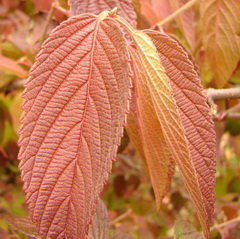 1996. Subsequently, it has migrated to ME, NH, VT and parts of PA and OH. In NY, they have been steadily moving south. Still north of my area, I will have to be on the lookout for them. Both the larvae and adults eat the viburnum foliage. Adults chew oblong holes in the leaves, while the larvae, which emerge from eggs that overwinter in the stems of new growth, chew along the leaf veins, leaving a skeletonized leaf in their wake. A number of successive seasons of damage can kill a plant. Pruning and destroying infested twigs after egg lay is the best way to stop the damage. Additionally, pesticides may be needed.
1996. Subsequently, it has migrated to ME, NH, VT and parts of PA and OH. In NY, they have been steadily moving south. Still north of my area, I will have to be on the lookout for them. Both the larvae and adults eat the viburnum foliage. Adults chew oblong holes in the leaves, while the larvae, which emerge from eggs that overwinter in the stems of new growth, chew along the leaf veins, leaving a skeletonized leaf in their wake. A number of successive seasons of damage can kill a plant. Pruning and destroying infested twigs after egg lay is the best way to stop the damage. Additionally, pesticides may be needed.
If I had to choose one favorite viburnum, it would probably be the doublefile 'Shasta' (V. plicatum f. tomentosum 'Shasta'), yet another USNA introduction. That botanical name is quite a mouthful for a plant that is a pure delight. It has a very distinctive horizontal habit, resulting in a final size of about six feet high by 10 - 12 feet wide. A true four - season shrub, it is literally covered in white blooms in spring for weeks. Sometimes I cannot even see the foliage from my house. This is followed by the 'Red Hot' berries, which the birds make short work of. The attractive green leaves have very prominent veins. The fall colors are in the bronze to burgundy range. Finally, in winter, one gets to admire the beautifully architectural structure. 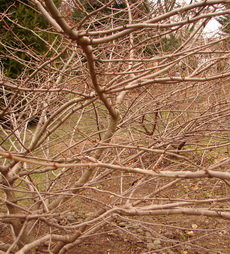
It is difficult to find a more deserving plant for your garden. Plant one, or many, this spring and you will be rewarded in so many ways for years to come. Bring home the queen!
Look for future articles on specific viburnum groups - dwarf, fragrant, fall color, etc.
Photos: 1. Doublefile 'Shasta' 2. 'Mohawk' 3. Sargent 'Onondaga' 4. Linden 'Erie'
5. rhytidophyllum 6. Arrowwood 'Blue Muffin' 7. Doublefile 'Mariesii'
8. Doublefile 'Shasta'
Sources: Thanks to viburnumvalley for his contribution.
U.S. National Arboretum Introductions
Clemson University - General Viburnum Information
Cornell Cooperative Extension - Viburnum Leaf Beetle
Trees & Shrubs Forum Viburnum Discussion
PlantFiles Viburnum Photos
Copyright © www.100flowers.win Botanic Garden All Rights Reserved